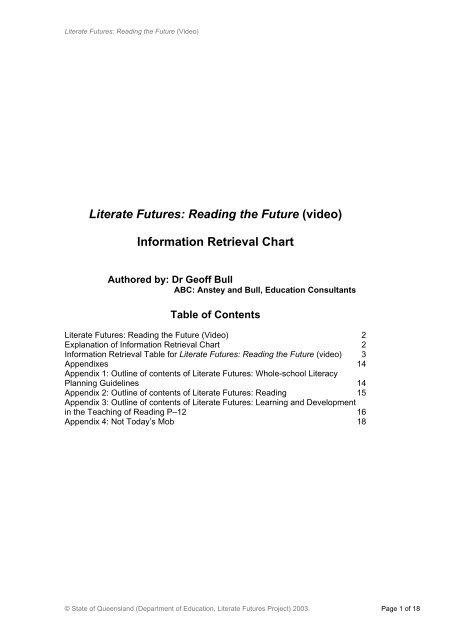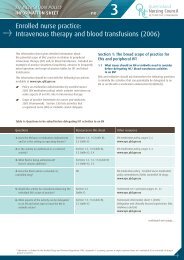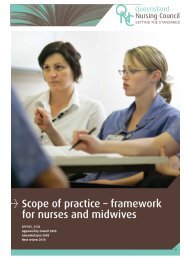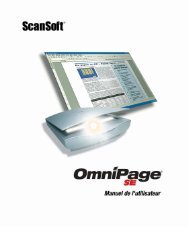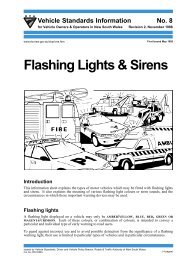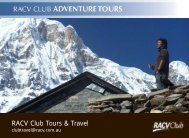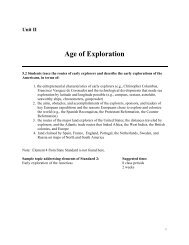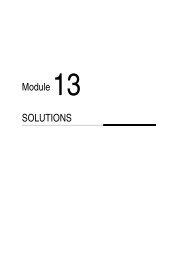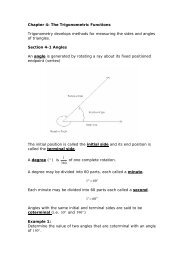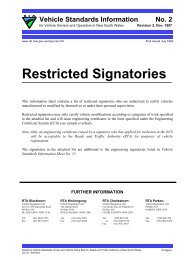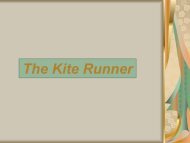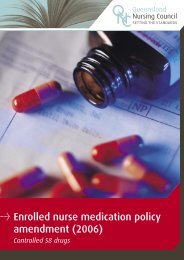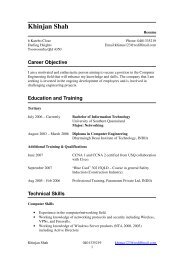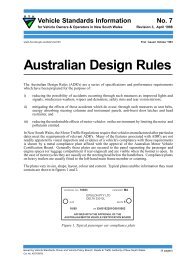Explanation of Information Retrieval Chart - Upload Student Web ...
Explanation of Information Retrieval Chart - Upload Student Web ...
Explanation of Information Retrieval Chart - Upload Student Web ...
Create successful ePaper yourself
Turn your PDF publications into a flip-book with our unique Google optimized e-Paper software.
Literate Futures: Reading the Future (Video)Literate Futures: Reading the Future (video)<strong>Information</strong> <strong>Retrieval</strong> <strong>Chart</strong>Authored by: Dr Ge<strong>of</strong>f BullABC: Anstey and Bull, Education ConsultantsTable <strong>of</strong> ContentsLiterate Futures: Reading the Future (Video) 2<strong>Explanation</strong> <strong>of</strong> <strong>Information</strong> <strong>Retrieval</strong> <strong>Chart</strong> 2<strong>Information</strong> <strong>Retrieval</strong> Table for Literate Futures: Reading the Future (video) 3Appendixes 14Appendix 1: Outline <strong>of</strong> contents <strong>of</strong> Literate Futures: Whole-school LiteracyPlanning Guidelines 14Appendix 2: Outline <strong>of</strong> contents <strong>of</strong> Literate Futures: Reading 15Appendix 3: Outline <strong>of</strong> contents <strong>of</strong> Literate Futures: Learning and Developmentin the Teaching <strong>of</strong> Reading P–12 16Appendix 4: Not Today’s Mob 18© State <strong>of</strong> Queensland (Department <strong>of</strong> Education, Literate Futures Project) 2003. Page 1 <strong>of</strong> 18
Literate Futures: Reading the Future (Video)Literate Futures: Reading the Future (Video)<strong>Explanation</strong> <strong>of</strong> <strong>Information</strong> <strong>Retrieval</strong> <strong>Chart</strong>The purpose <strong>of</strong> this <strong>Information</strong> <strong>Retrieval</strong> <strong>Chart</strong> is to:a. provide guidance on engagement with the video Literate Futures: Reading theFuture (RTF)b. make explicit the links between the video Literate Futures: Reading the Futureand the document Literate Futures: Reading (LFR)c. draw attention to links between RTF, LFR and other Education Queenslandinitiatives such as Productive Pedagogies.Using a videotext is a literacy skill that requires as much consideration as readinga traditional print text, if not more. Because the video RTF complements andreinforces the concepts presented in LFR, its content is very dense, and it raisesmany issues in a short time. Each <strong>of</strong> these issues is important to the teachingand learning <strong>of</strong> literacy.This video is a teaching and learning tool designed to engage teachers inanalysing and reflecting upon all the knowledges, experiences and resourcesthey already possess and can bring to the teaching <strong>of</strong> reading. This analysis andreflection will take place in the context <strong>of</strong> current and future concepts and issuesrelated to the teaching <strong>of</strong> reading.You will find the video more accessible if you keep the following questionsin mind while you view it:1. What resources do I need to access in order to understand the content <strong>of</strong> thevideo?2. What prior knowledges or experiences will I need to re-examine in order tounderstand, assimilate and take action regarding the issues raised in thevideo?To assist your viewing and appraising, the retrieval chart identifies each scene bynumber and gives a transcript <strong>of</strong> the narration. The questions or activitiessuggested in column three will assist you in dealing with the content and theissues raised. These questions and activities are related to the print documentssupplied to your school: Literate Futures: Reading; Literate Futures: Learning andDevelopment in the Teaching <strong>of</strong> Reading P–12 Positioning Document; andLiterate Futures: Whole-school Literacy Planning Guidelines. It is important thatyou access these documents while viewing the video to be able to make full use<strong>of</strong> all the documentation.View the video in its entirety, then go back and re-view it scene by scene,undertaking the questions and activities to fully appreciate the messages in thevideo. Viewing the video in a group will support the development <strong>of</strong> a SharedVision <strong>of</strong> literacy in your workplace.The purpose <strong>of</strong> the video and print documents is to raise awareness and assistyou in identifying individual and staff pr<strong>of</strong>essional development needs in reading.If you have difficulty with some activities, note them in the Reflection Questionssection <strong>of</strong> Literate Futures: Reading (e.g. pp. 12, 22 or 48) under the heading‘Are there things I need to know more about?’ By keeping this up to date you willgive direction to your planned use <strong>of</strong> the pr<strong>of</strong>essional development units on theTeaching <strong>of</strong> Reading that schools will have after July 2003.© State <strong>of</strong> Queensland (Department <strong>of</strong> Education, Literate Futures Project) 2003. Page 2 <strong>of</strong> 18
Literate Futures: Reading the Future (Video)<strong>Information</strong> <strong>Retrieval</strong> Table for Literate Futures: Reading the Future (video)SceneorimageScene/image description in video Question/activity Literate Futures:ReadingPositioningdocumentLiterate Futures: WholeschoolLiteracy PlanningGuidelines (WSLP)1. Back to the Future movie title mock up What does the title Back to the Future have todo with literacy?What features <strong>of</strong> intertextuality do you need toaccess to ‘read’ the title?Consult Figure 1(p. ix) for futuresorientation.Re-read pp. 1–3.Review RP 1 andPT 2 p. 2.Re-read definition<strong>of</strong> literacy skillson p. 18.Review RP andPT pp. 18–19.Readpp. 1–2.2. Every child comes to school each year with uniquesets <strong>of</strong> experiences and knowledges that connectthem through literacy practices with their homeand community. They are continually acquiringknowledge and skills that allow them to function inthis world that they know so intimately.In the classroom, success relies on their ability tounpack who they are and what they know, and tobe helped to extend these knowledges and skillsfor use in new contexts, for new purposes, usingnew tools.What experiences and resources (communityand cultural) are in play in these scenes? Howdo these resources vary with age?What do the different backpacks signify toyou?What cultural experiences and knowledges areindicated by the backgrounds to these scenes?Re-read pp. 10–11.Review RP andPT p. 11.Read sectionon Tayloristprinciplespp. 10–12.Relate to CommunityPr<strong>of</strong>ile and StrategicCommunity Partnerships1 RP = Refection Point2 PT = Pedagogical Thought© State <strong>of</strong> Queensland (Department <strong>of</strong> Education, Literate Futures Project) 2003. Page 3 <strong>of</strong> 18
Literate Futures: Reading the Future (Video)SceneorimageScene/image description in video Question/activity Literate Futures:ReadingPositioningdocumentLiterate Futures: WholeschoolLiteracy PlanningGuidelines (WSLP)3. Each day as readers we move in to and out <strong>of</strong> agreat number <strong>of</strong> environments and situations. Inthese situations we are called upon continually tomake sense <strong>of</strong> what we see and hear. We rely onour knowledge and experience to help makesense <strong>of</strong> the complex systems <strong>of</strong> signs, codes andconventions that make up what is said.How do you prepare students at school to dealwith the variety <strong>of</strong> environments and situationsthey will meet every day out <strong>of</strong> school?Re-read sectionon Technologicalchange pp. 4–5.For a discussion<strong>of</strong> signs, codesand conventionssee the section onSemiotic Systemsp. 20.Use Community Pr<strong>of</strong>iles toidentify theseenvironments.4. We need to make meaning <strong>of</strong> the world so that wecan interact within our community and the widerworld … access the information we need …understand more about our thoughts andemotions … communicate appropriately … makethings happen and get what we want.How do these scenes relate to activecitizenship? What does ‘active citizenship’mean to you?For anexplanation <strong>of</strong>Active Citizenshipsee New Basics:CurriculumOrganiserspp. 11–14.Use Community Pr<strong>of</strong>ileand Strategic CommunityPartnerships to identifywhat active citizenshipmeans and how it isenacted in your schoolcommunity.5. To function effectively in these manyenvironments we need to be literate.Does ‘functioning’ in a school environmentmake a student literate? Why or why not?(You may need to re-view Scene 5 in order toanswer this question.)Review PTp. 5.Use Community Pr<strong>of</strong>ileand Strategic CommunityPartnerships to identifyliteracies needed t<strong>of</strong>unction in yourcommunity.© State <strong>of</strong> Queensland (Department <strong>of</strong> Education, Literate Futures Project) 2003. Page 4 <strong>of</strong> 18
Literate Futures: Reading the Future (Video)SceneorimageScene/image description in video Question/activity Literate Futures:ReadingPositioningdocumentLiterate Futures: WholeschoolLiteracy PlanningGuidelines (WSLP)6. There is no simple, or common definition <strong>of</strong>literacy. Rather, we operate with an understandingthat literacy empowers us and connects ussocially, culturally, ideologically, economically andpolitically to the world around us.How does literacy empower us in the situationsdepicted in Scene 6?SociallyCulturallyRe-readpp. 4–11Review RPpp. 6, 11.IdeologicallyEconomicallyPolitically(You may need to re-view Scene 6 to answerthis question.)7. With the multiplicity <strong>of</strong> communicationtechnologies, and the increasing cultural andlinguistic diversity in our contemporary society, wecan take a much broader view <strong>of</strong> literacy. In fact,now we talk about many literacies ormultiliteracies because we recognise that allknowledge cannot be translated into words. Oftenother codes and conventions are more appropriatefor the audience and context such as images orsymbols.Traditional print and language approaches toliteracy are no longer sufficient. This does notmean, however, they are no longer necessary.What are someexamples <strong>of</strong>multiliteracies?What are the codesand conventions?What codes and conventions (other than print)are employed in Scene 7? What multiliteraciesare present?Re-read pp. 13–14.Re-view RPpp. 13, 14, 30.Re-view PT p. 14.Use Community Pr<strong>of</strong>ile andStrategic CommunityPartnerships to identifyexamples <strong>of</strong> multiliteraciesin your community.© State <strong>of</strong> Queensland (Department <strong>of</strong> Education, Literate Futures Project) 2003. Page 5 <strong>of</strong> 18
Literate Futures: Reading the Future (Video)SceneorimageScene/image description in video Question/activity Literate Futures:ReadingPositioningdocumentLiterate Futures: WholeschoolLiteracy PlanningGuidelines (WSLP)8. Allan Luke dialogue—Literacy for New TimesFeatures <strong>of</strong>Print LiteracySociallyCulturallyIdeologicallyEconomicallyPoliticallyFeatures <strong>of</strong> literacy forNew Times.Re-read p. 15.Re-view Lukedialogue9. As recently as fifty years ago the nation had quitea different view <strong>of</strong> what was necessary to equip aperson for the literacy demands <strong>of</strong> the workplaceand society.Although a migrant program was operating, thecountry was still seen as a monoculture.Education focused mainly on the presentation <strong>of</strong>British and European literary traditions and correctspeech.For many, a job <strong>of</strong>fered lifelong security. Therewas an emphasis on family values, parenting anddomestic practices.People listened avidly to the radio, readnewspapers for opinions <strong>of</strong> the day and went tothe cinema each week for another heart-racingsession <strong>of</strong> Buck Rogers in the 25 th Century.How have these developments shaped yourview <strong>of</strong> literacy? (Keep in mind that thosehistorical events that occurred before yourlifetime can still shape your opinions.)Consult Appendix4: Not Today’sMob (from theInternet). Thisdocument willgive you somebackground todraw on in orderto complete theactivity forScenes 10–14.© State <strong>of</strong> Queensland (Department <strong>of</strong> Education, Literate Futures Project) 2003. Page 6 <strong>of</strong> 18
Literate Futures: Reading the Future (Video)SceneorimageScene/image description in video Question/activity Literate Futures:ReadingPositioningdocumentLiterate Futures: WholeschoolLiteracy PlanningGuidelines (WSLP)10–14. Change, however, was already in the wind … ourcuriosity about the rest <strong>of</strong> the world finally got thebetter <strong>of</strong> us … fuelled by politics, a changingeconomy and the search for an identity …And <strong>of</strong> course … television …The 60s brought a new attitude to internationaltrade and relations. The Space Race influencedmoves to modernise industrially and domestically,and there was an orientation towards scientificand technological education.Put simply, we now looked to the world, inparticular America, for social, cultural andtechnological exemplars, and to Asia for economicexpansion.Mainhistoricaltrend orchange60s70s80s90s21 st Cent.Focus <strong>of</strong> literacy needed todeal with the trend or change10–14contd.The shift from sterling (1966) and a Labor government (1972) saw the 70s as a decade <strong>of</strong> reform. Traditional approaches and values were questioned as a largerproportion <strong>of</strong> the population was now from non–English-speaking backgrounds.By the 1980s we saw ourselves as a multicultural society with less emphasis on agricultural, manufacturing and service jobs, and a greater focus on ‘knowledge work’.The world seemed to shrink as communications networks expanded. We had become part <strong>of</strong> the global community.In the 1990s the focus was on ‘functional literacies’. Most workplaces were computerised … the types <strong>of</strong> jobs and working hours became flexible … and ongoingpr<strong>of</strong>essional skilling was seen as essential. Mass consumption <strong>of</strong> entertainment and the other products <strong>of</strong> information and communication technologies created newopportunities and new ways <strong>of</strong> interacting with the world. It also created a need to rethink and redefine ‘literacy’ for the new millennium.And that is the greatest challenge <strong>of</strong> literacy education this century … to plan for and teach literacy within culturally and linguistically diverse school communities using abroad range <strong>of</strong> strategies that take advantage <strong>of</strong> current and appropriate technologies.15. Clearly, reading is at the heart <strong>of</strong> literacy. We readfor knowledge, information and pleasure … or all<strong>of</strong> these combined … anywhere and at any time.We do so to enhance our abilities to contributeconstructively in our homes and communities, andto become active democratic citizens.What different resources are accessed whenwe read for knowledge, information orpleasure? (e.g. genres, prior knowledge orexperience.)Consider the implications<strong>of</strong> this for WSLP onclassroom organisationand pedagogy.16. Literacy is intimately bound up with language. Weneed to learn a language before we can becomeliterate users <strong>of</strong> it, and we use literacy as a way tolearn other things through language.What is the difference between language andliteracy?© State <strong>of</strong> Queensland (Department <strong>of</strong> Education, Literate Futures Project) 2003. Page 7 <strong>of</strong> 18
Literate Futures: Reading the Future (Video)SceneorimageScene/image description in video Question/activity Literate Futures:ReadingPositioningdocumentLiterate Futures: WholeschoolLiteracy PlanningGuidelines (WSLP)29–30. This billboard is also a text. It is constructed to sellproducts. There is no product name used, so thesymbol alone carries the message. Howeverwithout our prior knowledge and experience <strong>of</strong> thissymbol in other texts and in other contexts, wewould not make the intended meaning from themessage.Because <strong>of</strong> what we bring to the text weunderstand the Nike image through the use <strong>of</strong> thissymbol.Texts are not neutral; they do not carry just onemessage or meaning to all readers.How are the codes and conventions <strong>of</strong> film andadvertising different from those in print text?Re-read pp. 10,36 and 37.Review RP p. 36.31. Dialogue from Ilana Snyder—Technoliteracies. What is the difference betweentechnoliteracies and computer literacy?Re-view Snyderdialogue.32. Today we read with a growing number <strong>of</strong>multilinear or multisequential environments likegames platforms, multimedia platforms and theInternet. In these environments verbal and nonverbalinformation is linked by networks <strong>of</strong>associations that give the reader a choice <strong>of</strong>interactive pathways. In this environment authorand reader can share the same space.Codes andconventions <strong>of</strong>linear text.Codes and conventions<strong>of</strong> non-linear ormultilinear text.Reread pp. 4–5.Review RP p. 4.Review PT p. 5.© State <strong>of</strong> Queensland (Department <strong>of</strong> Education, Literate Futures Project) 2003. Page 10 <strong>of</strong> 18
Literate Futures: Reading the Future (Video)SceneorimageScene/image description in video Question/activity Literate Futures:ReadingPositioningdocumentLiterate Futures: WholeschoolLiteracy PlanningGuidelines (WSLP)33. The Internet or cyberspace has no centre point orhierarchy. There is no beginning, middle or end.<strong>Information</strong> here involves hypertext, which ismade up <strong>of</strong> text blocks that can be linked.Hypermedia extends the notion <strong>of</strong> this text byincluding video, music, animation, graphics, andstills. These information ‘blocks’ or ‘bricks’ linktogether in an ever-widening metatext or universe.34–37. Digital texts are not static or fixed, but dynamic,open and available. In this environment authorand reader can share the same space. More andmore teaching and learning can take advantage <strong>of</strong>these capabilities.How is reading different with these types <strong>of</strong>texts?What prior knowledge and skills are used?Linear textNon-linear textHypertextMetatextWhich resources from the Four Resourcemodel are used in this type <strong>of</strong> teaching?Review theactivities forScene 32.Reread pp. 39–41.34–37contd.The amount <strong>of</strong> information available on the Internet appears fathomless … seemingly beyond our abilities to process in a meaningful way. Therefore we must be moreselective, more critical and more analytical as readers. We need to be more discerning <strong>of</strong> the intent <strong>of</strong> the author and more purposeful in our own construction <strong>of</strong> texts.<strong>Student</strong>s must learn to work effectively and efficiently in these environments and acquire the skills and strategies necessary to become independent and resourcefulusers <strong>of</strong> text.Texts are changing, the tools we use to read and construct texts are changing, language and meaning are changing and technologies are continually changing, but thesefacts alone won’t determine the way we teach reading.38. Whole-school literacy strategies need to beinformed by conversations about what has tochange and what needs to stay the same in theteaching <strong>of</strong> reading. Teachers need to explorewhat ’new’ teaching practices in reading look like,teachers and parents need to investigate how toshape the necessary changes to help childrenread more productively.How will (has) your classroom pedagogychange(d) ?Reread p. 42– 43.Reread p. 45– 47.Review RP p. 42.Review PT p. 42.Read pp. 8–9. Read pp. 10–12.Re-examine your WSLP interms <strong>of</strong> Shared Vision andclassroom organisationand pedagogy.© State <strong>of</strong> Queensland (Department <strong>of</strong> Education, Literate Futures Project) 2003. Page 11 <strong>of</strong> 18
Literate Futures: Reading the Future (Video)SceneorimageScene/image description in video Question/activity Literate Futures:ReadingPositioningdocumentLiterate Futures: WholeschoolLiteracy PlanningGuidelines (WSLP)39. Community involvement, a shared vision and acommon language to discuss these issues arevital ingredients for ‘future pro<strong>of</strong>ing’ literacystrategies and ensuring a theorised and balancedapproach to the teaching <strong>of</strong> reading in everyschool.What do community involvement and a sharedvision have to <strong>of</strong>fer the teaching <strong>of</strong> reading?Reread thesection on theSocial CriticalApproachp. 47.Read p. 6.Read pp. 13–16.Re-examine your WSLP inrelation to your CommunityPr<strong>of</strong>ile and StrategicCommunity Partnerships40. In 2010 these students will be school leavers. RereadDestination–2010Read pp. 17–19, 21, 22.Read pp. 32–34.© State <strong>of</strong> Queensland (Department <strong>of</strong> Education, Literate Futures Project) 2003. Page 12 <strong>of</strong> 18
Literate Futures: Reading the Future (Video)AppendixesAppendix 1: Outline <strong>of</strong> content <strong>of</strong> Literate Futures: Whole-school Literacy PlanningGuidelinesPageContent6 five purposes in developing a whole-school literacy strategy through the school’s Annual OperationalPlan (AOP)7–8 the roles <strong>of</strong> principals, District Directors (now Executive Directors <strong>of</strong> Schools) and Learning andDevelopment Centres (Literacy)10 phases in the whole-school literacy planning process11 exploring the eight Key Aspects in whole-school literacy planning12 five aspects <strong>of</strong> effective whole-school literacy planning13 documenting the four points to be addressed in each school’s whole-school literacy strategy14–16 how to develop your whole-school literacy strategy17–22 key aspects <strong>of</strong> effective literacy planning23–29 linking whole-school literacy planning with EQ systemic initiatives30–31 using the whole-school literacy planning CD-ROM32–34 resources for supporting whole-school literacy planning© State <strong>of</strong> Queensland (Department <strong>of</strong> Education, Literate Futures Project) 2003. Page 14 <strong>of</strong> 18
Literate Futures: Reading the Future (Video)Appendix 2: Outline <strong>of</strong> content <strong>of</strong> Literate Futures: ReadingPage(vii)Contentstimulate conversations about reading; development <strong>of</strong> a repertoire <strong>of</strong> skills; semiotic systems1–2 theme <strong>of</strong> change: Literacy is for lifelong learning, not just for the next year-level or secondary school.Compare contemporary workplace literacy requirements with those <strong>of</strong> the 1950s—then wasessentially alphabetic and print-based, but served the needs <strong>of</strong> the times. The only technologies <strong>of</strong>mass media and communication were radio and print.3 citizens <strong>of</strong> globalised economies interact routinely with different groups, cultures, languages,communities, states and countries; therefore increased social diversity. Need to address homeschool-communityliteracies.4–5 technological changes: TV—free to air, digital, cable, satellite. Digital technologies widespread.Internet. Online gaming. CD-ROM. Video. Literacy demands <strong>of</strong> viewing still and moving images,symbols and icons, combination <strong>of</strong> verbal and non-verbal materials; hypertext, hypermedia.7 changes in workplace structures, organisation and literacy demands require collaborative socialbehaviours and a wide range <strong>of</strong> flexible literacy skills8 social change: growth in mass media systems and technologies, change in most population groups9 identity influenced by mass media and marketing10 uncritical consumption <strong>of</strong> consumerist products and ideas. Social complexities arising from culturaland linguistic diversity. Rich–poor gap widening, growing intergenerational unemployment with familytransience and diversity <strong>of</strong> personal experience, especially significant for teachers.13 multiliteracies, multimedia, technology and technoliteracies, critical literacy, cultural and linguisticdiversity14 hybrid and nonlinear texts. Transformation—reading requires critical literacy; the reader istransformed in the reading15 literacy a social act, not just cognitive and psychological; redesigning literacy; learning ‘how’, not just‘what’; repertoire <strong>of</strong> reading practices16–18 learning to be multiliterate; who constructs the meaning in texts? intertextuality20 variety <strong>of</strong> semiotic systems and symbols23–25 unpacking the reading definition for the teaching <strong>of</strong> reading27–37 unpacking the Four Resource model39–41 using the Four Resource model42–43 Figures 3 & 4—using the Four Resource model in planning; a procedure for analysing texts45–47 Table 1—current theories and approaches to teaching reading in terms <strong>of</strong> Four Resource model© State <strong>of</strong> Queensland (Department <strong>of</strong> Education, Literate Futures Project) 2003. Page 15 <strong>of</strong> 18
Literate Futures: Reading the Future (Video)Appendix 3: Outline <strong>of</strong> contents <strong>of</strong> Literate Futures: Learning and Developmentin the Teaching <strong>of</strong> Reading P–12Page(iv)Contentdesigned to help curriculum leaders engage staff in learning and development activities around theteaching <strong>of</strong> reading, recognising that all schools are at different stages in literacy development.1 background to the focus on the teaching <strong>of</strong> reading: QSE–2010 – all schools must equip students todeal better with diversity in the 21 st century – all students must be active citizens, engage in lifelonglearning, and have an equitable chance at the same outcomes. underpins School Improvement andAccountability Framework (SIAF)2 how all the source documents feed into one another5 purpose and use <strong>of</strong> book, video and CD-ROM6 outline <strong>of</strong> book, video and CD-ROM9 putting it all together to form a school-based strategy for reading across the school.10–14 Addressing key issues; explaining the move away from Taylorist organisational principles© State <strong>of</strong> Queensland (Department <strong>of</strong> Education, Literate Futures Project) 2003. Page 16 <strong>of</strong> 18
Literate Futures: Reading the Future (Video)Appendix 4: Not Today’s Mob(Received from a friend over the Internet.)I can't believe WE made it! If you lived as a child in the 40s, 50s, 60s or 70s, looking back, it's hardto believe that we have lived as long as we have … As children, we would ride in cars with no seatbelts or air bags.Riding in the back <strong>of</strong> a pickup truck on a warm day was always a special treat. Our baby cribs werecovered with bright coloured lead–based paint. We had no childpro<strong>of</strong> lids on medicine bottles,doors, or cabinets, and when we rode our bikes, we had no helmets—not to mention hitchhiking totown as a youngster!We drank water from the garden hose and not from a bottle. Horrors! We would spend hoursbuilding our go-carts out <strong>of</strong> scraps, and then ride down the hill only to find out we had forgotten thebrakes. After running into the bushes a few times we learned to solve the problem.We would leave home in the morning and play all day, as long as we were back in time for tea. Noone was able to reach us all day. No cell phones. Unthinkable.We played rounders and sometimes the ball would really hurt. We got cut and broke bones andbroke teeth, and there were no law suits from these accidents. They were accidents.No one was to blame, but us. Remember accidents?We had fights and punched each other and got black and blue and learned to get over it. We atecupcakes, bread and butter, and drank cordial, but we were never overweight … we were alwaysoutside playing. We shared one lemonade, raspberry or orange fizzy with four friends, from onebottle and no one died from this.We did not have PlayStations, Nintendo 64, X-Boxes, video games at all, 99 channels on cable,videotape movies, surround sound, personal cell phones, personal computers, Internet chat rooms… we had friends. We went outside and found them. We rode bikes or walked to a friend's homeand knocked on the door, or rang the bell or just walked in and talked to them, or played boardgames, or did jig-saw puzzles.Imagine such a thing. Without asking a parent! By ourselves! Out there in the cold cruel world!Without a guardian. How did we do it? We made up games with sticks and tennis balls and ateworms and although we were told it would happen, we did not put out very many eyes, nor did theworms live inside us forever.We tried out for school sports teams and not everyone made the team. Those who didn't had tolearn to deal with disappointment … Some students weren't as smart as others so they failed agrade and were held back to repeat the same grade … Horrors. Tests were not adjusted for anyreason.Our actions were our own. Consequences were expected. No one to hide behind. The idea <strong>of</strong> aparent bailing us out if we broke a law was unheard <strong>of</strong>. Parents actually sided with the law, imaginethat! This generation has produced some <strong>of</strong> the best risk-takers and problem solvers and inventorsever. The past 50 years has seen an explosion <strong>of</strong> innovation and new ideas. We had freedom,failure, success and responsibility, and we learned how to deal with all <strong>of</strong> them. And you're one <strong>of</strong>them. Congratulations! Please pass this on to others who have had the luck to grow up as kids,before lawyers and government regulated our lives, for our own good.Bryan John Jones© State <strong>of</strong> Queensland (Department <strong>of</strong> Education, Literate Futures Project) 2003. Page 18 <strong>of</strong> 18


